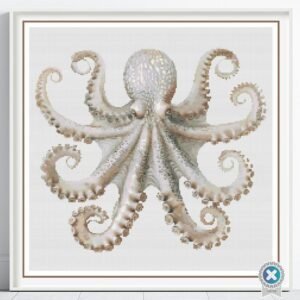Selecting the Correct Floss for Your Cross Stitch Project
Counted cross stitch has very few strict rules — the most important one is to enjoy yourself. Whether you’re following a commercial kit or creating your own design, choosing the right floss (thread) can make a big difference in your project’s appearance, durability, and stitching experience.
This guide will help you understand floss types, how to choose quality threads, and what to do when you want to change colours, brands, or textures.
🎨 1. What Is Floss and Why It Matters
Floss is the thread you use to bring your design to life. It comes in many materials, finishes, and qualities, and your choice affects how your final piece will look and feel.
Good floss should be:
Colour-fast, so it won’t bleed or fade.
Smooth and durable, resisting fraying or tangling.
Well-matched to your fabric’s texture and colour.
Appropriate for the project’s purpose (for example, colour-fast and washable for items like bibs or towels).
🧵 2. Choosing the Right Floss Type
Cotton stranded floss (like DMC or Anchor) is the most common and versatile. It’s usually a 6-strand divisible thread, allowing you to separate strands depending on how much coverage you need.
Other specialty floss types include:
Silk floss – luxurious sheen, ideal for heirloom pieces.
Rayon (viscose) – glossy but slippery; handle carefully.
Metallic threads – perfect for sparkle or accents, but can fray easily.
Variegated or hand-dyed threads – add beautiful colour transitions, but dye lots may vary.
When using specialty threads, always consider how your finished item will be used. For example, avoid non-colour-fast silks for baby bibs or other washable items.
🧩 3. What If the Kit Floss Is Poor Quality?
Not all kits provide high-quality threads. If your kit’s floss feels rough, breaks easily, or looks dull, you can replace it.
Check the chart: Some kits list the brand and colour numbers. If you have this info, simply buy better-quality replacements (for example, DMC or Anchor).
If no chart is provided: Use a colour card from a major brand to match shades. Choose one with real thread samples and match under natural daylight for accuracy.
No colour card? Take the original floss to a local needlework shop and compare directly, but be cautious — indoor lighting can distort colours.
Once matched, note the DMC (or other brand) numbers on your chart for future use.
 4. Changing Brands or Converting Colours
4. Changing Brands or Converting Colours
If you prefer a different brand of floss than what your pattern suggests, look for a floss conversion chart. Many are available online and in books.
For example, you can convert Anchor → DMC or DMC → Cosmo using published tables or even online lookup tools.
This is especially handy if you live in an area where your preferred brand is easier to find, or if you want to ensure colour consistency across multiple projects.

🎨 5. Want a Different Look or Texture?
Changing the thread texture or finish can transform your design. Consider metallics, hand-painted silks, or blending filaments for sparkle.
Always test your thread first — specialty fibres may require shorter lengths or thread conditioner to reduce tangling.
If you’re swapping colours entirely, especially in a complex design, make sure your new palette maintains the same value contrast (lightness/darkness). You can check this by viewing your colours through red cellophane or by photocopying them in black and white — the tonal balance should match the original.
🧭 6. Understanding “Z-Twist” and “S-Twist” Threads
You may come across terms like Z-twist or S-twist when reading about fibres.
These refer to the direction of the thread’s twist:
Z-twist: The twist runs from top right to bottom left (like the middle stroke of a “Z”).
S-twist: The twist runs from top left to bottom right (like the middle of an “S”).
Most embroidery floss is Z-twisted. This affects how the thread behaves when you stitch — twisting the needle in the wrong direction can cause the strands to untwist. If your thread starts to separate or look fuzzy, try letting your needle dangle occasionally to release the twist.
🪡 7. Practical Tips for Perfect Floss Selection
Always test floss colours next to your fabric in natural light.
Use shorter lengths (about 18 inches or 45 cm) to prevent fraying and knotting.
Keep track of dye lots when using hand-dyed threads — buy all skeins for your project at once.
Organize your floss by brand and number using bobbins, cards, or binders.
Store floss away from direct sunlight and moisture to prevent fading.
When in doubt, invest in high-quality, colour-fast threads — your time is worth more than a small saving on materials.
💬 Final Thoughts
Selecting the right floss for your cross stitch project combines both art and practicality. Whether you’re replacing poor-quality kit floss, converting to a new brand, or experimenting with new fibres, understanding your options helps you stitch confidently and creatively.
As with every aspect of cross stitch, there’s no single “right” way — only the way that makes your stitching most enjoyable. Choose quality materials, trust your eye, and let your creativity shine through every stitch.
🧵 Patterns you may enjoy
-
Animals
Boho Octopus Cross Stitch Pattern
€ 6.50 – € 11.99Price range: € 6.50 through € 11.99 Select options This product has multiple variants. The options may be chosen on the product page -
Cross Stitch Patterns
Beach Panorama Cross Stitch Pattern
€ 6.50 – € 11.99Price range: € 6.50 through € 11.99 Select options This product has multiple variants. The options may be chosen on the product page -
Animals
Alaskan Malamute Sleeping Cross Stitch Pattern
€ 6.50 – € 13.99Price range: € 6.50 through € 13.99 Select options This product has multiple variants. The options may be chosen on the product page
Need other help?
I’m only too happy to answer any general or pattern-specific questions you may have!
Please send me a note via the CONTACT US page.




